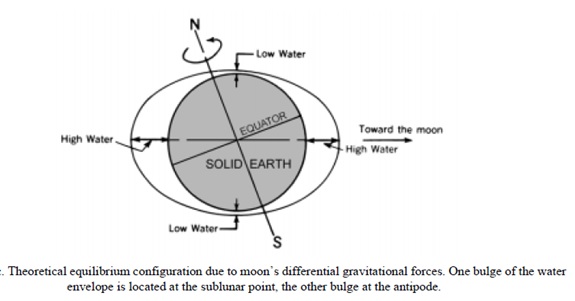- Earth & Moon exist in isolation
- Earth is a non rotating sphere
- A single ocean encircles the globe
- Ocean is static i.e. has no currents
- The only forces acting on ocean result from the movement of Earth & Moon about their common center of mass.
Shortcomings of the Equilibrium Model :
- It predicts semidiurnal tides at all locations – not observed
- It predicts that high tides should occur when moon passes overhead or 12 hours 25 minutes later – rarely observed
- Calculations suggest that tidal ranges should be 20-50 cm- observed tidal ranges are often much larger.
- It predicts values for daily inequities that are rarely observed.
Dynamical Theory of Tides :
- Begins where equilibrium model ends, i.e. with two bulges created by gravitational interactions of Earth & Moon.
- Explains real tides by envisioning tidal bulges as tidal wave
- Tidal wave has small wave height-about 50 cm in open ocean
- Tidal Wave has a very long wavelength(L) about one half of earth’s circumference = 20,000 kms.
- Water Depth of oceans = 4 km <<<<< L/2
- Tidal Wave is a shallow water Wave everywhere, i.e. in interacts continually with the ocean bottom
- As a shallow water wave, tidal wave feels the bottom, slows, steepens and sometimes breaks
- Tidal Wave reflects, refracts & interferes with other waves or with reflections of itself
- Depending upon the shape of a basin, the net result may be a standing wave that corresponds to a diurnal tide, a semidiurnal tide, or a mixed tide.
Effect of Changes in distances of Sun & Moon
- As the orbits of the earth round the sun, and of the moon round the earth, especially the latter, are slightly elliptical, small changes in distances occur. The variation in the Moon’s distance can cause a difference in range of Lunar tide raising force from 15 to 20%. The variation in the Sun’s distance can cause a difference of only about 3 percent in the Solar tide raising force.
- Thus there is a tendency for the tides to be larger at Perigee than at Apogee and a similar, but lesser tendency for the tides to be larger at Perihilion than at Aphelion.
The Effect of Shallow Water
- The tide raising forces set up oscillations of small amplitude in the deep oceans and these oscillations travel as waves towards the coast, into estuaries & up rivers. As the water becomes shallower the amplitude of the wave increases & further amplification occurs when the tidal wave travels up an estuary which, typically, gradually narrows from a wide entrance.
- The effect of a tidal wave entering shallow waters is, besides increasing the amplitude of the wave, to distort it in the same way that an ordinary wave on the beach may be observed to become progressively distorted as it approaches the shore; it tends to aquire a steep front, that is to say that the period of rise becomes shorter than the period of fall. These shallow water effects are present to a greater or lesser degree in the tides of all coastal waters and they make the prediction of such tides more complex than for simple oceanic tides.
Points to pounder :
- The tides are caused due to the forces which act between the Earth, Sun, Moon & the water mass of the Earth.
- It is also affected by the motion of the Moon & Sun relative to Earth.
- The Earth Motion on its own axis is also to be considered.
- As per Newton’s law of gravitation F = M1 x M2 / d2
Where F is the Force between Earth & Moon, d is the distance between their centres & M1 & M2 are their masses. Similarly there is also a gravitational pull between Earth & Sun.



